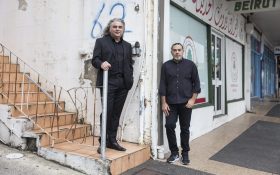Late last week (Saturday 18 June), the family of potter Merran Esson (1950-2022) posted on social media channels that she had peacefully passed away after her long battle with illness. She was 72.
‘Mum was always surrounded by her community and people who love her, and the last weeks and hours of her life were of no exception. Mum had battled a brain tumour for almost two years, but the end was calm and peaceful.’
Diagnosed in July 2020, in many ways Esson’s battle was very ‘everyday’, sharing her journey on social media – always surrounded by her family and never giving up her passion for making. It was a diagnosis that came after COVID isolation, and with it a frustration as a potter, impacting her balance and dexterity.
But in her true spirit, it did not stop her. It was during this time that she also saw a monograph on her work published, titled A life of collecting, and artist Susan Doherty painted her portrait, which was included in the 2020 Salon des Refusés at the S.H. Ervin Gallery.
Fond tributes flooded social media this week by many who Esson’s gentle spirit, earthy talent, warmth and humour had touched.
Clay is such a willing material. My imprint on the clay surface will stay there forever.
Merran Esson, Artist Profile interview 2016.
For over 40 years, Esson had made her passion of working with clay her career, both as an educator and an exhibiting artist. She loved to feel the clay in her hands. She has even said that her favourite ‘tool’ are her fingers, ‘dragging texture across slabs of clay.’
Esson grew up in Southern NSW, in the Snowy Mountain foothills and the town of Tumbarumba. Understandably, the landscape was ingrained in her creative expression, from references to rustic objects used on the farm and the minutiae and pattinas of their wear, to her later life living in Woolloomooloo, and the stacked city landscape that surrounded her.
‘I always thought I would return to the land, and when I discovered ceramics I imagined a studio behind a woolshed somewhere,’ she told Artist Profile in an earlier interview.
‘I am a practical girl, and I watched my father and grandfather fix things as farmers do. It was not always beautiful, but over time a patina builds up and something once practical takes on its own beauty,’ Esson continued.
Like most potters of the day, Esson had been inspired by Bendigo Pottery in Victoria in the early 1970s, going on to study Ceramics at Caulfield Institute of Technology in Melbourne (now Monash University). She also did the common post-uni move to London, which broadened her view of the medium.
Although her early ceramic pieces were functional ware, largely for the home, she soon became interested in the intersection of clay and nature. By her mid-career, she was making pieces that evoked aging due to water and time, objects often encrusted like something found under the sea.
But her work changed course in 2000, and the period that followed offered great wins for Esson – both creatively and in her career. Her simplified, sculptured forms became more angular and abstract, often pierced or perforated to allow the light to filter through, or tactile to reflect found surfaces.
She increasingly became known for her use of bold coloured glazes, and her ceramics became larger in scale, confidently holding their own in a gallery space.
Esson won the Port Hackers Potters Award that year (2000), received her Master of Art Degree from Monash University (2004), was then awarded the 24th Gold Coast International Ceramic Award in 2005, and in 2006 the National Art School Studio Residency at The Cite Internationale des Arts Paris.
It was a pivotal moment for Esson, and it charted the way forward – a period that was to cement her place in Australian Ceramics.
In 2016, Esson went to Spain to attend the 47th International Academy of Ceramics Congress in Barcelona. Its theme ‘Ceramics in Architecture and Public Space’ appealed to Esson and her vision to push her practice further. She had just completed a major installation for the 2016 Sculpture by the Sea before she left.
‘I am excited to install this new work in the landscape. I think the exposure of my work on the shoreline of Bondi to Tamarama will lead me on to other things. Fired ceramics is durable in all weather, as we know from roof tiles; it requires no maintenance, so potentially my works could last outside forever. This is an exciting time for me,’ she told Artist Profile at the time.

The work had become more land based – in and of the land – embedded both conceptually and physically.
In the ensuing years, she was a regular finalist in key prizes including the Woollahra Small Sculpture Prize, Sculpture by the Sea, Sculpture in Scenic World, Sculpture in the Valley, The University of Western Sydney Sculpture Award, Blacktown Art Prize and the Ravenswood Women’s Art Prize taking her through to COVID.
In 2019 she was the winner of the Woollahra Small Sculpture Prize with the installation Autumn on the Monaro, and the same year also won the Muswellbrook Art Prize in Ceramics, with Broken Buckets, Breaking Boundaries.
Esson continued to work and show to the end. Only a few months ago her work was included in the Destination Sydney Exhibition at the Manly Art Gallery and Museum, visiting the gallery to see the work installed. She was also included in the important Clay Dynasty exhibition at the Powerhouse Museum (still on display).
And only last month (June 2022), Esson saw three of her works acquired for the Snowy Valleys Sculpture Trail, a new and significant series of sculpture collections that connected with her home town of Tumbarumba, among others.
On the occasion of her work being shown at Hurstville Museum Gallery in 2019, she said, ‘patience and instinct play a great role in who succeeds with this material [clay].’
Esson had both. She was also resourceful, improvising with a surface or a glaze that may have gone wrong, or using the marks from her hand as a cue to the next move. It is these marks that will always be with us – her legacy.
More on Merran Esson
Esson’s work is held in the international collections: Argentona Ceramics Museum, Spain, Museum für Kunsthandwerk und Gewerbe in Hamburg, the Westerwalld Keramik Museum, Hohr-Grenzhausen, Koblenz, Germany, National Taiwan University of Arts, Yingge Ceramics Museum, Taiwan, as well as the National Gallery of Australia, Art Galleries of South Australia and Western Australia, Gold Coast City Art Gallery, Bathurst Art Gallery, Muswellbrook Shire Art Collection, Woollahra Council and numerous galleries and museums in Australia.
Esson has exhibited in The Victoria and Albert Museum London, Galerie Rosenhauer in Germany, Gaffer Gallery in Hong Kong, also in Korea, Taiwan, Sweden, Pakistan, Spain, Japan and numerous galleries in Australia. She has been a visiting artist in China, Korea, Scotland, Sweden, Taiwan, Japan, Spain and Pakistan.
As a teacher she started at Kambala Girls School before teaching at various TAFE colleges, University of NSW Art and Design, the Australian Catholic University, and the National Art School Sydney (as early as 1997), where she was Head of Ceramics.
She also taught at Edinburgh College of Art in Scotland, Glasgow School of Art, Xi’an Academy of Fine Arts in Beijing and Central Academy of Fine Art in Beijing.
She was a member of the International Academy of Ceramics, Geneva and was represented by Stella Downer Fine Art in Sydney.
Esson is survived by her children, Kirsty, James, Karen and Family.





